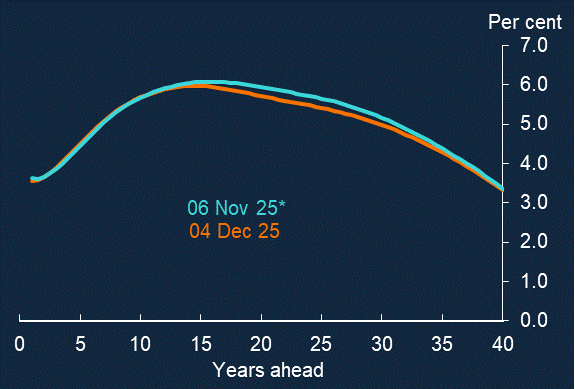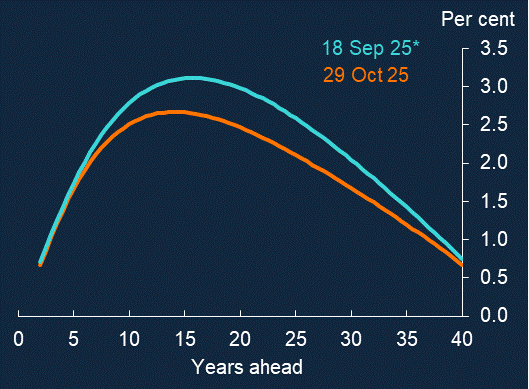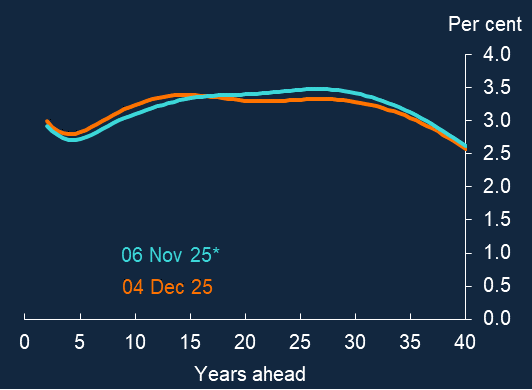Macroeconomics, the economy, inflation etc. *likely to be very dull*

A bit of a weird yield curve, but still vaguely normal looking if you ignore the rates.

UK instantaneous implied real forward curve (gilts)
This is what it looks like in real terms. Starting to look a bit bonkers. Note the scales - negative real rates for 40 years. I remember when this first went negative and broke many of the systems.

UK instantaneous implied inflation forward curve (gilts)
And this what inflation (RPI) looks like. A good 20 years above 3%.

Comments
-
At a tangent but do you know why the inflation curve does not dip down when RPI is replaced with CPI in 2030?
In pension trustee meeting we are shown these curves with CPI approx 0.8% below RPI then it jumps up to match RPI in 2030 and adds £35m to our liabilities. Are the markets assuming the BofE will boost the economy to hit their inflation target using the new index?0 -
It's a good question and I don't know the answer. It contains the note published below. The problem with this is that it is a market implied rate, so I am not sure how there can be any consideration to methodology - it should simple reflect the market's view. Even if many people believe they will successfully sue the government for compensation or that it won't happen, you would still expect there to be a discount and therefore a change at that point.surrey_commuter said:At a tangent but do you know why the inflation curve does not dip down when RPI is replaced with CPI in 2030?
In pension trustee meeting we are shown these curves with CPI approx 0.8% below RPI then it jumps up to match RPI in 2030 and adds £35m to our liabilities. Are the markets assuming the BofE will boost the economy to hit their inflation target using the new index?No methodological change has been implemented following the conclusion of the consultation on reform to RPI methodology, published as part of the 2020 Spending Review. The impact on the estimated yield curves of the UKSA proposal to align methods and data sources of RPI with that of CPIH in February 2030 is currently under review.
0 -
Interesting - it is one if those ones where I poke my head above the parapet and say that makes no sense and the actuaries shrug their shoulders and duck behind "but that is what the market says"TheBigBean said:
It's a good question and I don't know the answer. It contains the note published below. The problem with this is that it is a market implied rate, so I am not sure how there can be any consideration to methodology - it should simple reflect the market's view. Even if many people believe they will successfully sue the government for compensation or that it won't happen, you would still expect there to be a discount and therefore a change at that point.surrey_commuter said:At a tangent but do you know why the inflation curve does not dip down when RPI is replaced with CPI in 2030?
In pension trustee meeting we are shown these curves with CPI approx 0.8% below RPI then it jumps up to match RPI in 2030 and adds £35m to our liabilities. Are the markets assuming the BofE will boost the economy to hit their inflation target using the new index?No methodological change has been implemented following the conclusion of the consultation on reform to RPI methodology, published as part of the 2020 Spending Review. The impact on the estimated yield curves of the UKSA proposal to align methods and data sources of RPI with that of CPIH in February 2030 is currently under review.0 -
I'm like this in some free art galleries, I look around for a moment, don't get it and wander off again.1
-
We need a little explanatory panel to bring us outsiders up to speed.veronese68 said:I'm like this in some free art galleries, I look around for a moment, don't get it and wander off again.
"In this piece, TheBigBean explores themes of..."1985 Mercian King of Mercia - work in progress (Hah! Who am I kidding?)
Pinnacle Monzonite
Part of the anti-growth coalition2 -
I'll be the volunteer dozing in the corner- Genesis Croix de Fer
- Dolan Tuono0 -
source?
The inflation numbers look broadly in line with what the BoE is mandated to deliver (given the difference between RPI and CPI) - so these figures are hardly a surprise, surely? Inflation at that level not necessarily a bad thing, unless ofc you're receiving income from a non-indexed (or inappropriately indexed) source.0 -
Perhaps I should have included the word juxtaposition.rjsterry said:
We need a little explanatory panel to bring us outsiders up to speed.veronese68 said:I'm like this in some free art galleries, I look around for a moment, don't get it and wander off again.
"In this piece, TheBigBean explores themes of..."1 -
The last graph tells us that the markets think the BofE will not hit it's target of 2% for decades. This may of course be that their new target will be CPI and that will be 0.8% lower.mr.b-campag said:source?
The inflation numbers look broadly in line with what the BoE is mandated to deliver (given the difference between RPI and CPI) - so these figures are hardly a surprise, surely? Inflation at that level not necessarily a bad thing, unless ofc you're receiving income from a non-indexed (or inappropriately indexed) source.
It will be a bad thing if they cannot get out of index linked gilts using RPI as it will cost them a lot of money0 -
Source BoE. 2.5% RPI target became 2% CPI target. It is quite a lot higher than 2.5% for some time.mr.b-campag said:source?
The inflation numbers look broadly in line with what the BoE is mandated to deliver (given the difference between RPI and CPI) - so these figures are hardly a surprise, surely? Inflation at that level not necessarily a bad thing, unless ofc you're receiving income from a non-indexed (or inappropriately indexed) source.
0 -
Thanks. I'm not sure about your point re the target - what that graph shows is broadly in line with the BoE's target (esp. given the likely margin of error - does the BoE not produce a fan chart for this?), which is expressed in terms of CPI (assuming there is a stable relationship betwen the two). Whilst it does look a bit above that for quite some time, I'm not sure I agree it is quite a lot higher.
What is the debt service on the outstanding gilts that are linked to RPI, and what is their maturity profile? Presumably most of that debt is being rolled over into CPI indexed (or non-indexed) debt? Iirc the whole point of linking them to a measure of inflation is to give credibility to inflation targets i.e. to give government the incentive to avoid the pain you mention and not try and inflate its debts away. Arguably the market's forecast might look rather different were it not so.0 -
Above 3% will require regular letters to the chancellor explaining why they have breached your target. If you look at this historical graph you will see that the market is pricing in a big long term increasemr.b-campag said:Thanks. I'm not sure about your point re the target - what that graph shows is broadly in line with the BoE's target (esp. given the likely margin of error - does the BoE not produce a fan chart for this?), which is expressed in terms of CPI (assuming there is a stable relationship betwen the two). Whilst it does look a bit above that for quite some time, I'm not sure I agree it is quite a lot higher.
What is the debt service on the outstanding gilts that are linked to RPI, and what is their maturity profile? Presumably most of that debt is being rolled over into CPI indexed (or non-indexed) debt? Iirc the whole point of linking them to a measure of inflation is to give credibility to inflation targets i.e. to give government the incentive to avoid the pain you mention and not try and inflate its debts away. Arguably the market's forecast might look rather different were it not so.
https://d3fy651gv2fhd3.cloudfront.net/charts/united-kingdom-inflation-cpi.png?s=ukrpcjyr&v=202107140807V20200908&ismobile=1&w=400&h=250&lbl=0&d1=19210808&type=line
Index linked gilts are designed to get a positive rate of return
0 -
It is the market implied rate, so it is what you get by backsolving current index-linked gilt prices. I imagine it is possible to create a fan chart, but I haven't seen one and I imagine it would rapidly diverge.mr.b-campag said:Thanks. I'm not sure about your point re the target - what that graph shows is broadly in line with the BoE's target (esp. given the likely margin of error - does the BoE not produce a fan chart for this?), which is expressed in terms of CPI (assuming there is a stable relationship betwen the two). Whilst it does look a bit above that for quite some time, I'm not sure I agree it is quite a lot higher.
A lot higher is a subjective matter. It peaks at 3.69% in 10 years time. It has certainly been higher in the past. It's odd to have inflation this higher and yet interest rates still so low. It has been like this for 10 years though, so is the new normal which is not expected to change.
The gilts aren't rolled into CPI, but from 2030, they are planning to change the methodology behind RPI to make it the same as CPI. This is controversial as the plan is to not pay any compensation for this change when I imagine compensation would be due if they switched the contractual index from RPI to CPI.mr.b-campag said:
What is the debt service on the outstanding gilts that are linked to RPI, and what is their maturity profile? Presumably most of that debt is being rolled over into CPI indexed (or non-indexed) debt? Iirc the whole point of linking them to a measure of inflation is to give credibility to inflation targets i.e. to give government the incentive to avoid the pain you mention and not try and inflate its debts away. Arguably the market's forecast might look rather different were it not so.
0 -
I think youre explaining why when I bought some UK gilt indexed funds at the start of the pandemic thinking they might be safe they lost value just like shares and then sort of meandered back to where they were with hardly any prospect of making me any money ever.
They seem to be as attractive as premium bonds !0 -
You won't get returns without risk.mully79 said:I think youre explaining why when I bought some UK gilt indexed funds at the start of the pandemic thinking they might be safe they lost value just like shares and then sort of meandered back to where they were with hardly any prospect of making me any money ever.
They seem to be as attractive as premium bonds !
I'll be by the fire exit having a fag.0 -
The gilts aren't rolled into CPI, but from 2030, they are planning to change the methodology behind RPI to make it the same as CPI. This is controversial as the plan is to not pay any compensation for this change when I imagine compensation would be due if they switched the contractual index from RPI to CPI.
Wow, sneaky! Any idea of the potential magnitude of this? Govt. tells us to fund our own pensions and then goes on to undermine them (I'm assuming pensions are one of the main holders of these in their portfolios)...0 -
How are the gov't undermining pensions?mr.b-campag said:The gilts aren't rolled into CPI, but from 2030, they are planning to change the methodology behind RPI to make it the same as CPI. This is controversial as the plan is to not pay any compensation for this change when I imagine compensation would be due if they switched the contractual index from RPI to CPI.
Wow, sneaky! Any idea of the potential magnitude of this? Govt. tells us to fund our own pensions and then goes on to undermine them (I'm assuming pensions are one of the main holders of these in their portfolios)...0 -
Forcing pension schemes to hold gilts and then forcing down the price of gilts through QE?rick_chasey said:
How are the gov't undermining pensions?mr.b-campag said:The gilts aren't rolled into CPI, but from 2030, they are planning to change the methodology behind RPI to make it the same as CPI. This is controversial as the plan is to not pay any compensation for this change when I imagine compensation would be due if they switched the contractual index from RPI to CPI.
Wow, sneaky! Any idea of the potential magnitude of this? Govt. tells us to fund our own pensions and then goes on to undermine them (I'm assuming pensions are one of the main holders of these in their portfolios)...
I know you will not sympathise with holders of DB schemes but they will take a serious hit from annual increases switching to CPI0 -
I'll be honest, I'm not massively familiar with what the rule is to hold gilts. Is it specifically holding gilts or is that part of rules around liquidity and liabilities?0
-
It amounts to one and the same thing, though inceasingly schemes are working around it with LDI (derivatives that hedge against interest/inflation rate fluctuations)rick_chasey said:I'll be honest, I'm not massively familiar with what the rule is to hold gilts. Is it specifically holding gilts or is that part of rules around liquidity and liabilities?
0 -
I thought as much. The rules are there to protect pensioners from the fund falling over. I think they're reasonable in principle.surrey_commuter said:
It amounts to one and the same thing, though inceasingly schemes are working around it with LDI (derivatives that hedge against interest/inflation rate fluctuations)rick_chasey said:I'll be honest, I'm not massively familiar with what the rule is to hold gilts. Is it specifically holding gilts or is that part of rules around liquidity and liabilities?
0 -
but QE suppresses the gilt curve which massively raises liabilities whilst reducing returns.rick_chasey said:
I thought as much. The rules are there to protect pensioners from the fund falling over. I think they're reasonable in principle.surrey_commuter said:
It amounts to one and the same thing, though inceasingly schemes are working around it with LDI (derivatives that hedge against interest/inflation rate fluctuations)rick_chasey said:I'll be honest, I'm not massively familiar with what the rule is to hold gilts. Is it specifically holding gilts or is that part of rules around liquidity and liabilities?
Don't forget the damage done to annuities which penalises those who want the comfort of a fixed income or don't have the condfidence to manage their own drawdown scheme0 -
You need to look at everything relative to the market expectations. For them to increase in value you would need market expectations of inflation to increase and interest rates to lower.mully79 said:I think youre explaining why when I bought some UK gilt indexed funds at the start of the pandemic thinking they might be safe they lost value just like shares and then sort of meandered back to where they were with hardly any prospect of making me any money ever.
They seem to be as attractive as premium bonds !0 -
It is not up to the gov't to make your investments work. It is up to the gov't to make sure the pension funds don't fall over from bad management when they run into liquidity problems.surrey_commuter said:
but QE suppresses the gilt curve which massively raises liabilities whilst reducing returns.rick_chasey said:
I thought as much. The rules are there to protect pensioners from the fund falling over. I think they're reasonable in principle.surrey_commuter said:
It amounts to one and the same thing, though inceasingly schemes are working around it with LDI (derivatives that hedge against interest/inflation rate fluctuations)rick_chasey said:I'll be honest, I'm not massively familiar with what the rule is to hold gilts. Is it specifically holding gilts or is that part of rules around liquidity and liabilities?
Don't forget the damage done to annuities which penalises those who want the comfort of a fixed income or don't have the condfidence to manage their own drawdown scheme
The entitlement that you think the gov't should prop your own investments up!!0 -
Inflation hedging is costly though. You should ask them how much you are paying for it at your next meeting.surrey_commuter said:
It amounts to one and the same thing, though inceasingly schemes are working around it with LDI (derivatives that hedge against interest/inflation rate fluctuations)rick_chasey said:I'll be honest, I'm not massively familiar with what the rule is to hold gilts. Is it specifically holding gilts or is that part of rules around liquidity and liabilities?
0 -
we thought about it for 4 years so not sure I want to reopen that can of wormsTheBigBean said:
Inflation hedging is costly though. You should ask them how much you are paying for it at your next meeting.surrey_commuter said:
It amounts to one and the same thing, though inceasingly schemes are working around it with LDI (derivatives that hedge against interest/inflation rate fluctuations)rick_chasey said:I'll be honest, I'm not massively familiar with what the rule is to hold gilts. Is it specifically holding gilts or is that part of rules around liquidity and liabilities?
0 -
Staying at about 3% over decades doesn't look like running out of control. I'd guess it's not worse than undershooting.0
-
What you need to do is to forget about what you paid for them and to make a decision of what is the best thing to be in now.mully79 said:I think youre explaining why when I bought some UK gilt indexed funds at the start of the pandemic thinking they might be safe they lost value just like shares and then sort of meandered back to where they were with hardly any prospect of making me any money ever.
They seem to be as attractive as premium bonds !
A big difference betwen professional and amateur investors is knowing when to take a loss.0 -
Sunk costs are so hard to ignore, but sound afvice SC.0
-
Took me decades to figure that outmr.b-campag said:Sunk costs are so hard to ignore, but sound afvice SC.
My FiL has “too many” Nat West shares and is waiting for them to get back above water. It boggles the mind how much he could have made if he sold out and bought a tracker0






